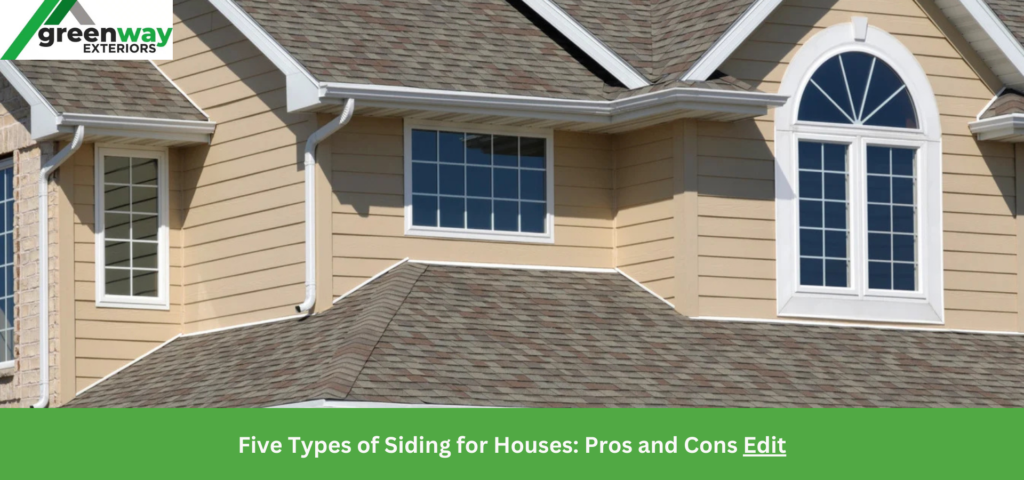Five Types of Siding for Houses: Pros and Cons

Choosing the right siding for houses is a crucial decision for homeowners. The siding you select not only impacts your home’s appearance but also affects its energy efficiency, maintenance needs, and long-term durability. In this article, we’ll explore five popular types of siding for houses, examining their pros and cons to help you make an informed choice.
1. Vinyl Siding
Pros of Vinyl Siding
Vinyl siding is one of the most popular choices among homeowners. Its appeal lies in its affordability, durability, and variety of styles and colors. Here are some advantages of vinyl siding for houses:• Cost-Effective: Vinyl siding is often less expensive than other materials, making it a great option for budget-conscious homeowners.
• Low Maintenance: It requires minimal upkeep, needing only occasional cleaning with soap and water.
• Durability: Vinyl siding can withstand harsh weather conditions, such as rain, wind, and snow, without warping or cracking.
• Energy Efficiency: Many vinyl siding products come with insulation options that can help improve your home’s energy efficiency.
Cons of Vinyl Siding
While vinyl siding has many benefits, it’s not without its drawbacks:
• Fading: Over time, vinyl can fade in color due to prolonged exposure to sunlight.
• Limited Repair Options: If damaged, vinyl siding often needs to be replaced rather than repaired, which can be costly.
• Environmental Concerns: Vinyl is made from PVC, which raises environmental concerns regarding its production and disposal.
2. Wood Siding
Pros of Wood Siding
Wood siding is known for its natural beauty and timeless appeal. Here are some pros of choosing wood siding for houses:
• Aesthetic Appeal: Wood provides a classic, warm look that can enhance the character of any home.
• Insulation: Wood is a natural insulator, helping to keep homes warmer in winter and cooler in summer.
• Variety: Available in many species, wood siding can be stained or painted in various colors.
Cons of Wood Siding
Despite its beauty, wood siding has some notable disadvantages:
• Maintenance: Wood siding requires regular maintenance, including painting, staining, and sealing to protect it from moisture and pests.
• Cost: It can be more expensive than other siding materials, both in terms of upfront costs and ongoing maintenance.
• Susceptibility to Pests: Wood can be vulnerable to termites and other pests if not properly treated.
3. Fiber Cement Siding
Pros of Fiber Cement Siding
Fiber cement siding has gained popularity in recent years due to its durability and low maintenance needs. Here are some advantages:
• Durability: Resistant to rot, pests, and fire, fiber cement siding can last for decades with proper installation.
• Low Maintenance: Unlike wood siding, fiber cement doesn’t require frequent painting or staining.
• Variety of Styles: It can mimic the appearance of wood, stucco, or masonry, providing homeowners with many design options.
Cons of Fiber Cement Siding
While fiber cement siding is a strong choice, it has a few drawbacks:
• Weight: It is heavier than other siding materials, which can increase installation costs and complexity.
• Installation Costs: Hiring skilled siding contractors for installation can be more expensive than for lighter materials.
• Potential Cracking: If not installed correctly, fiber cement can crack under certain conditions.
4. Stucco Siding
Pros of Stucco Siding
Stucco siding is often associated with Mediterranean-style homes and offers a distinct look. Its benefits include:
• Durability: Stucco is strong and can withstand extreme weather conditions.
• Energy Efficiency: With proper insulation, stucco siding can provide excellent energy efficiency.
• Customizability: Available in various colors and textures, stucco can enhance the aesthetic appeal of a home.
Cons of Stucco Siding
However, stucco siding also comes with some cons:
• Cracking: It can crack over time due to settling or shifting in the foundation.
• Moisture Issues: If not properly installed, stucco can trap moisture, leading to mold and rot.
• Limited Flexibility: Once installed, changing the color or texture of stucco is challenging compared to other siding options.
5. Brick Siding
Pros of Brick Siding
Brick siding offers a classic and robust aesthetic. Here are some of its advantages:
• Longevity: Brick is one of the most durable siding options available, often lasting for decades without needing replacement.
• Low Maintenance: Brick requires minimal maintenance, mainly occasional cleaning.
• Energy Efficiency: It provides excellent insulation, keeping homes warm in winter and cool in summer.
Cons of Brick Siding
Despite its many benefits, brick siding has some disadvantages:
• Cost: Brick siding can be one of the more expensive siding options, both for materials and installation.
• Limited Design Options: While it can be painted, most homeowners prefer to leave brick as is, which limits color options.
• Heavy Weight: The weight of brick requires a strong foundation and skilled installation, increasing labor costs.
The Expert Siding Contractor in Wichita
When it comes to siding for houses, each type has its unique advantages and disadvantages. Vinyl siding offers cost-effectiveness and low maintenance, while wood provides natural beauty at the expense of higher upkeep. Fiber cement is durable and versatile, stucco offers a distinct look, and brick stands out for its longevity and low maintenance.
Ultimately, your choice will depend on your budget, aesthetic preferences, and maintenance willingness. If you’re considering replacement siding for your home, we invite you to contact Greenway Exteriors. As a leading siding contractor in Wichita, KS, we’re committed to helping you select the best siding option for your needs. Our expert team can guide you through the selection process and ensure professional installation for long-lasting results. Reach out to Greenway Exteriors today, and let’s enhance your home’s exterior together.
Greenway Exteriors
2807 W River Park Dr, Wichita, KS 67203
(316) 641-8365
